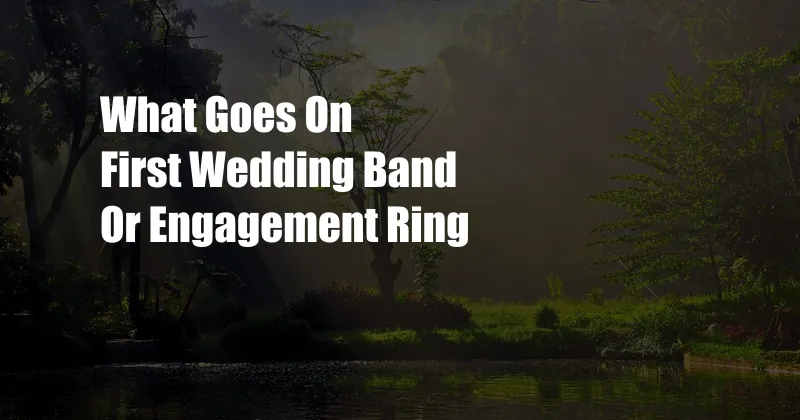
Which Band Goes on First: Wedding Band or Engagement Ring?
The wedding band and engagement ring, symbols of love and commitment, hold a special place in the lives of married couples. It is widely accepted tradition to wear the engagement ring on the left-hand ring finger, but the placement of the wedding band can lead to confusion. This article delves into the etiquette and history behind the placement of engagement and wedding bands.
From the moment of a heartfelt proposal, the engagement ring becomes a beautiful token of love and anticipation. In the United States and many other Western cultures, it is customary to wear it on the left-hand ring finger. This tradition stems from the belief that a vein, known as the “vena amoris” or “vein of love,” runs directly from the left-hand ring finger to the heart, symbolizing the direct connection between the heart and the person being loved.
The Wedding Band: A Promise of Forever
The wedding band signifies the union of two people in marriage. It is traditionally worn on the left-hand ring finger, below the engagement ring. The placement of the wedding band below the engagement ring represents the promise of a lasting commitment built upon the foundation of love. The two bands worn together become a physical representation of the journey from courtship to marriage.
Bridal Sets: A Contemporary Interpretation
Bridal sets offer a modern twist on the traditional wedding band placement. Bridal sets combine an engagement ring and a wedding band designed to fit together perfectly. They eliminate the question of which ring goes on first, providing a seamless and cohesive look. Bridal sets are particularly popular among couples who prefer a more contemporary and unified aesthetic.
Ring Stacking: A Creative Expression
In recent years, ring stacking has emerged as a fashionable trend. This involves wearing multiple rings on the same finger, creating a unique and eye-catching look. Stacking rings can include a combination of engagement rings, wedding bands, and other special rings. The versatility of ring stacking allows for personal expression and individuality.
Tips for Choosing the Perfect Band
Choosing the right wedding band that complements the engagement ring is crucial. Here are some expert tips to guide you in your selection:
- Consider the metal of both rings. Matching metals create a cohesive look, while contrasting metals can add a touch of drama.
- Think about the width and style of the wedding band. A wider band can balance a larger engagement ring, while a delicate band can complement a more modest ring.
- Consider engraving both rings with meaningful dates, names, or special messages to make them even more personal.
Frequently Asked Questions
- Q: Which hand do I wear my wedding ring on?
A: Traditionally, the wedding ring is worn on the left-hand ring finger. - Q: Should the wedding band always be worn below the engagement ring?
A: Yes, if you are not wearing a bridal set. - Q: Can I wear more than one engagement ring?
A: Yes, engagement rings can be stacked to create a layered look. - Q: Can I wear my engagement ring after I get married?
A: Yes, you can continue to wear your engagement ring after your wedding, but it is typically worn above the wedding band.
Final Thoughts
The placement of engagement and wedding bands is a matter of personal choice and tradition. Whether you prefer the classic placement of the wedding band below the engagement ring or opt for a contemporary bridal set, your choice should reflect the love and commitment you share with your partner. The rings you adorn symbolize a journey of love and the beautiful promise of forever together.
Would you like to know more about wedding and engagement ring traditions and trends? Share your thoughts and questions below, and let’s continue the conversation.